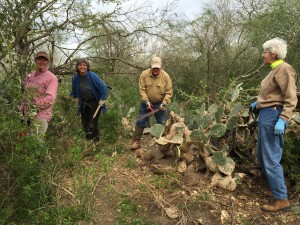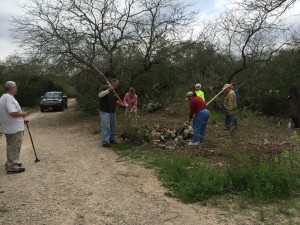Four hours hard labor; Nine happy people
Thursday, February 12th the weather was perfect for demolition and reconstruction. We were to clear an overgrown area on Ebony Loop near Coral Bean Cove in Hugh Ramsey Nature Park. The dual purpose project included making brush piles with the debris.
Things to consider in designing brush piles

Ultimately, the decayed matter from the brush piles will enrich the soil, an especially important product since all that great nature in Ramsey Park is sitting atop an old landfill. While the decaying process takes place (years), the pile itself is fascinating. It provides shelter for woodland creatures and quickly becomes its own unique eco system; decomposing vegetation provides a habitat for invertebrates that will in turn be eaten by birds and other critters. Vines and other sprawling nectar plants can be planted next to the piles to cover and camouflage the debris and attract butterflies. The list goes on.
Putting aside our fascination of the far-reaching effects of a pile of debris, we arrived at our predetermined site and discovered two huge, unsightly stacks that had been piled next to the trail. We realized immediately the stacks needed to be moved. There are aesthetics to consider, as well.
Instead of being dismayed, the group had a “Let’s get started,” attitude. The planners amongst us began forging our way around sprawling prickly pear cactus, and through overgrown granjeno branches, overhanging dead mesquite limbs and knee-high clumps of Guinea grass.
After assessing the situation, we decided to clear the Guinea grass from where we would build the brush stacks, but first we would need to clear a path of cactus, mesquite branches and thorny brush so we could safely maneuver. We presented the plan to our guru, Frank Wiseman, who approved and offered valuable guidance and ideas.
Blazing a trail
As Pamela-the-Guinea-Grass-Queen Gregory and Kim Kirby worked with garden forks tackling the grass, the rest of us grabbed loppers, saws and a machete. Mario Moreno and James Seguin came along with chainsaws for the big stuff. Other members of the Great Demolition Team were Anita Westervelt, Gregory Storms, Louise Wilkinson, Barbara Peet and Karren Sheiner.

Once the area was ready for us to start building our brush piles, we used the largest limbs for each base of the two piles we had decided to build. Most had been cut into four- to five-foot lengths. We progressively piled thinner and springier branches and brush on top and then weighted the piles with cactus and clumps of Guinea grass. Cactus pads and grass roots will not propagate as long as they are not touching the soil. We constructed two great brush piles relatively close to the trail, but not readily visible. The first pile was near a pack rat home that we left undisturbed. Pack rats (packrat, wood rat) will eat the cactus, I’ve been told, and use sticks and other debris for building.
But there’s more
Frank, supervisor extraordinaire, was eyeing an old stand of partially dead prickly pear cactus that was encroaching on the trail. Voicing his thoughts, he said, “It would be nice if one day we could clear . . . .” And with the last dregs of energy, the team tackled the cactus patch.

We did disturb a pack rat, in a small structure it had created in the cactus, but we pointed him toward the newly constructed piles, which, in the end, connected together to form one heck of a pack rat condo complex.
I’d like to see our chapter master naturalists think about building beneficial brush piles when we’re clearing trails and tending gardens. After all, the plant matter serves our projects no environmental purpose when it’s hauled off or dumped in a landfill.
Comments about brush piles
- Easy and quick way to make a yard animal friendly
- Best located about 25 feet from family activity
- Good shelter for animals during cold snaps and extreme heat

Leave a Reply